Data on births presented in this release were obtained from the timely and late registered births at the Office of the City Civil Registrar of Las Piñas and submitted to the Office of the Civil Registrar General through the Philippine Statistics Authority – National Capital Region - Provincial Statistical Office V (PSA-NCR-PSO V). The information presented includes births by the usual residence of the mother that occurred from January to December 2023 based on data files received by the PSA - Civil Registration Service (CRS) from the PSOs and processed as of 31 August 2024. The figures presented herein are not adjusted for under registration.
Registered live births in the City of Las Piñas slightly increased in 2023.
In 2023, a total of 7,337 live births were registered in the City of Las Piñas, corresponding to a crude birth rate (CBR) of 11.6, or approximately 12 births per 1,000 population. Over the past decade, the city recorded a significant decline in registered live births, contracting by 34.9 percent from 11,268 births in 2014 to 7,337 births in 2023. This downward trend was momentarily interrupted by a slight increase of 1.0 percent in 2023, following the 1.4 percent growth observed in 2022, after the substantial 18.1 percent decline recorded in 2021 at the height of the COVID-19 pandemic. On a daily average, around 20 live births were registered in the City of Las Piñas in 2023. (See Figure 1)
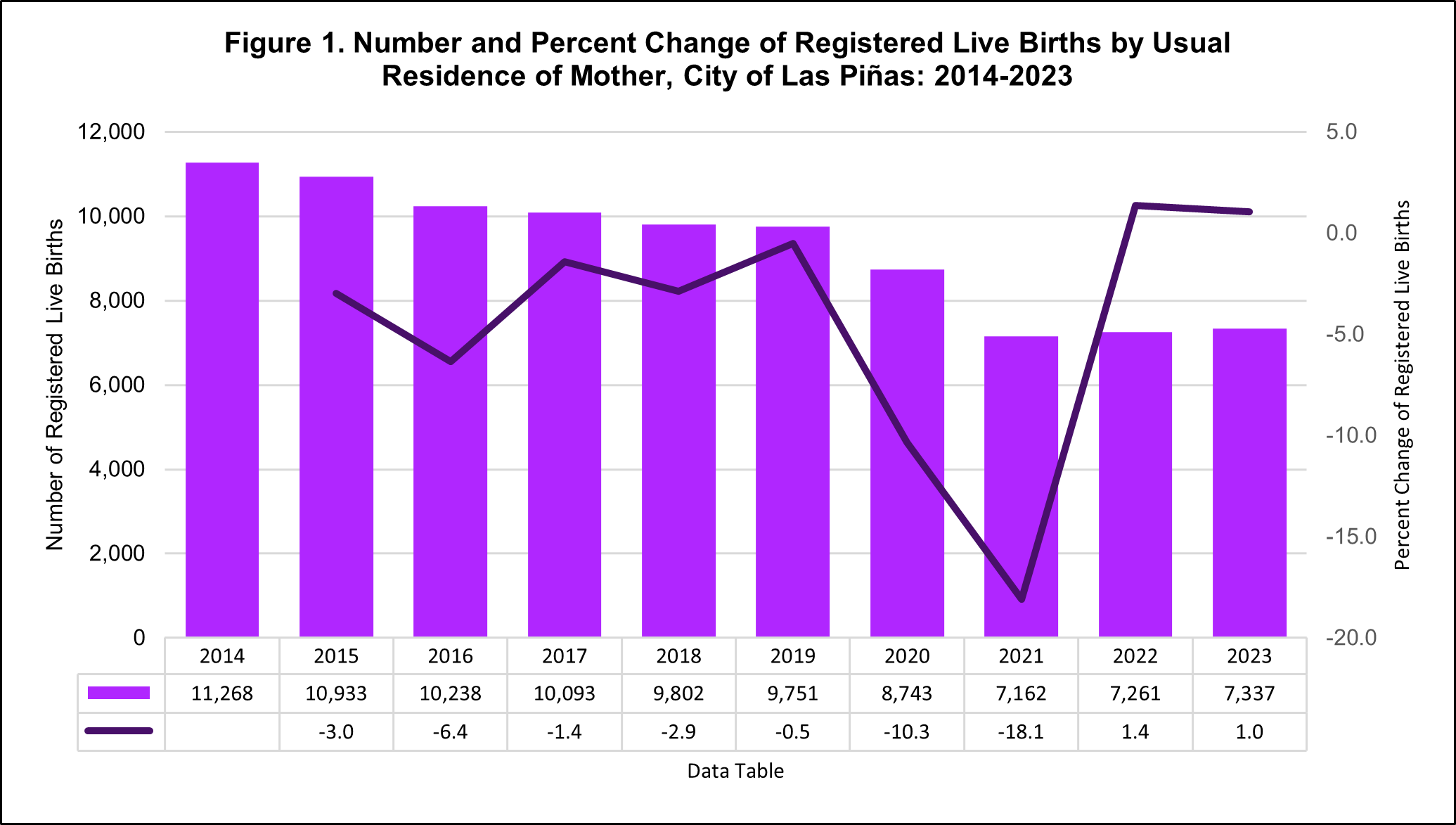
Source: Philippine Statistics Authority, Civil Registration Service, Vital Statistics Division
Male births outnumbered female births in the recorded data.
From January to December 2023, male live births slightly outnumbered female births, with 3,752 males recorded, accounting for 51.1 percent of the total, compared to 3,585 females or 48.9 percent. This gender distribution resulted in a sex ratio at birth of 105 males for every 100 females. Notably, this pattern was consistent with the figures observed in 2022, where males also comprised the majority of births. That year, 3,862 male births were registered, representing 53.2 percent, while females numbered 3,399 or 46.8 percent, yielding a higher sex ratio at birth of 114 males per 100 females. The data suggest a persistent trend of male predominance in live births over the two-year period, with a slight decrease in the male-to-female ratio in 2023 compared to the previous year. (See Figures 2 and 3)
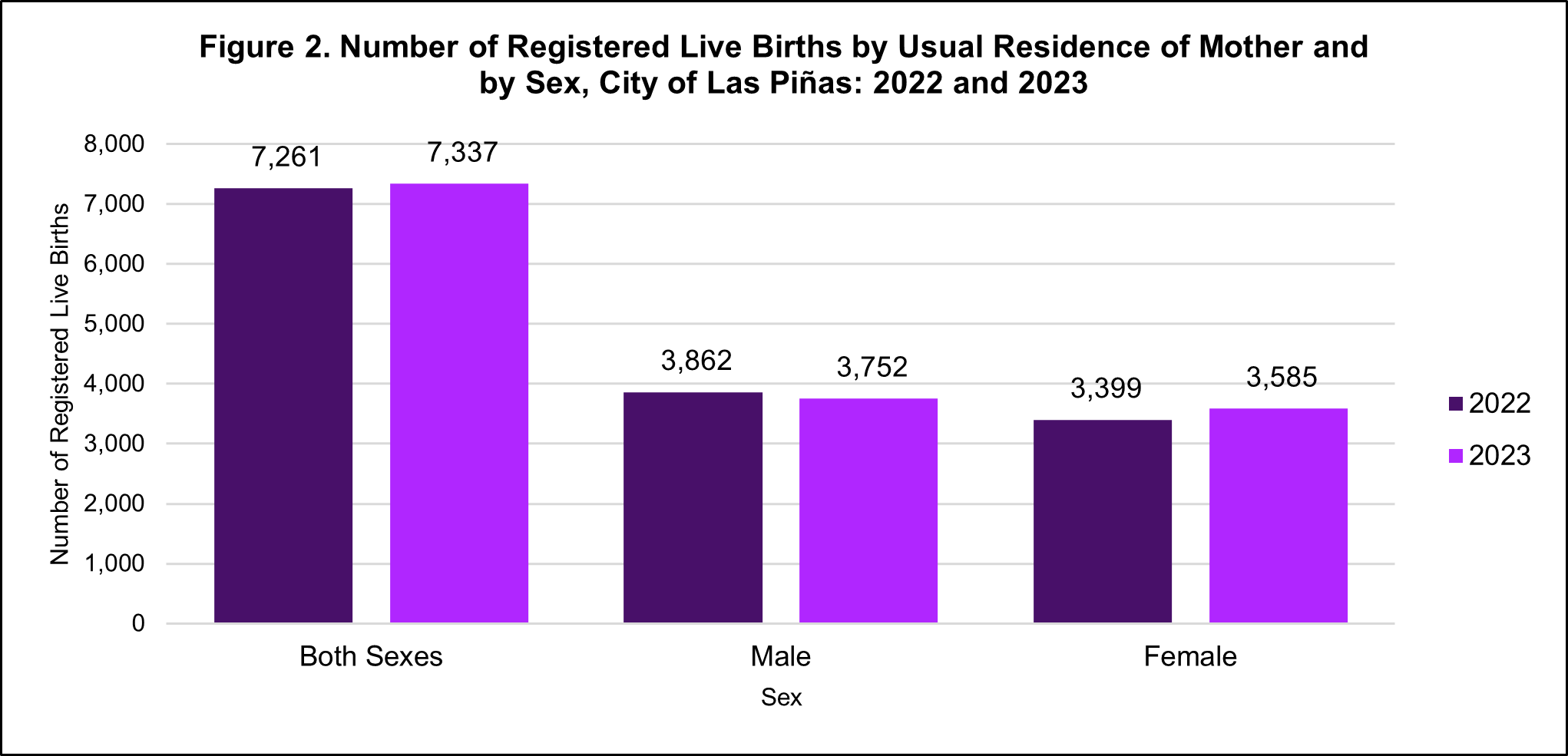
Source: Philippine Statistics Authority, Civil Registration Service, Vital Statistics Division
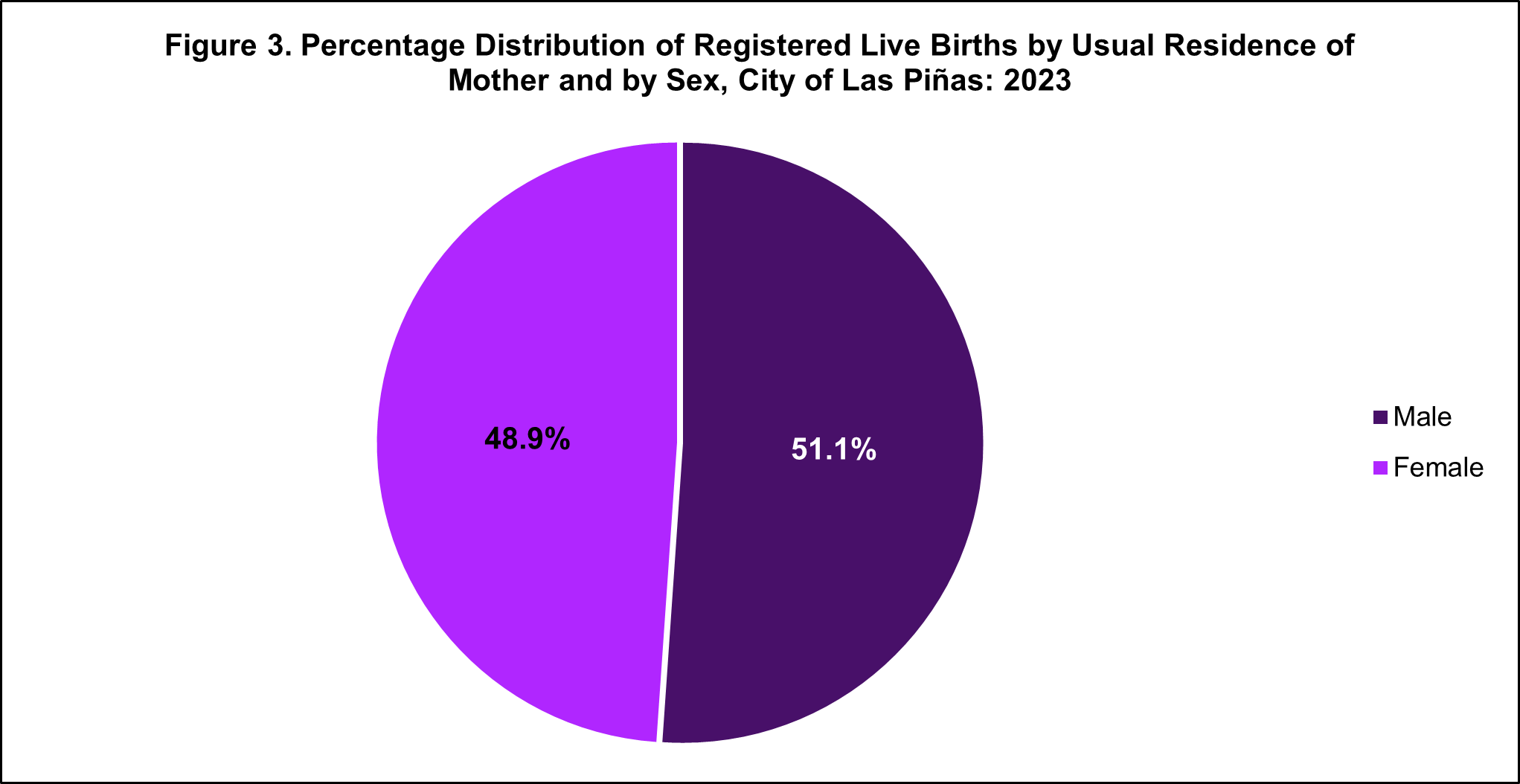
Source: Philippine Statistics Authority, Civil Registration Service, Vital Statistics Division
Most number of births were registered in September.
The peak month for registered live births in 2023 was September, accounting for 683 births, or 9.3 percent of the total births in the city. This was closely followed by the months of October and December, each contributing 9.0 percent to the overall birth count. Conversely, February recorded the lowest incidence of live births, accounting for only 6.9 percent of the total. (See Figure 4)
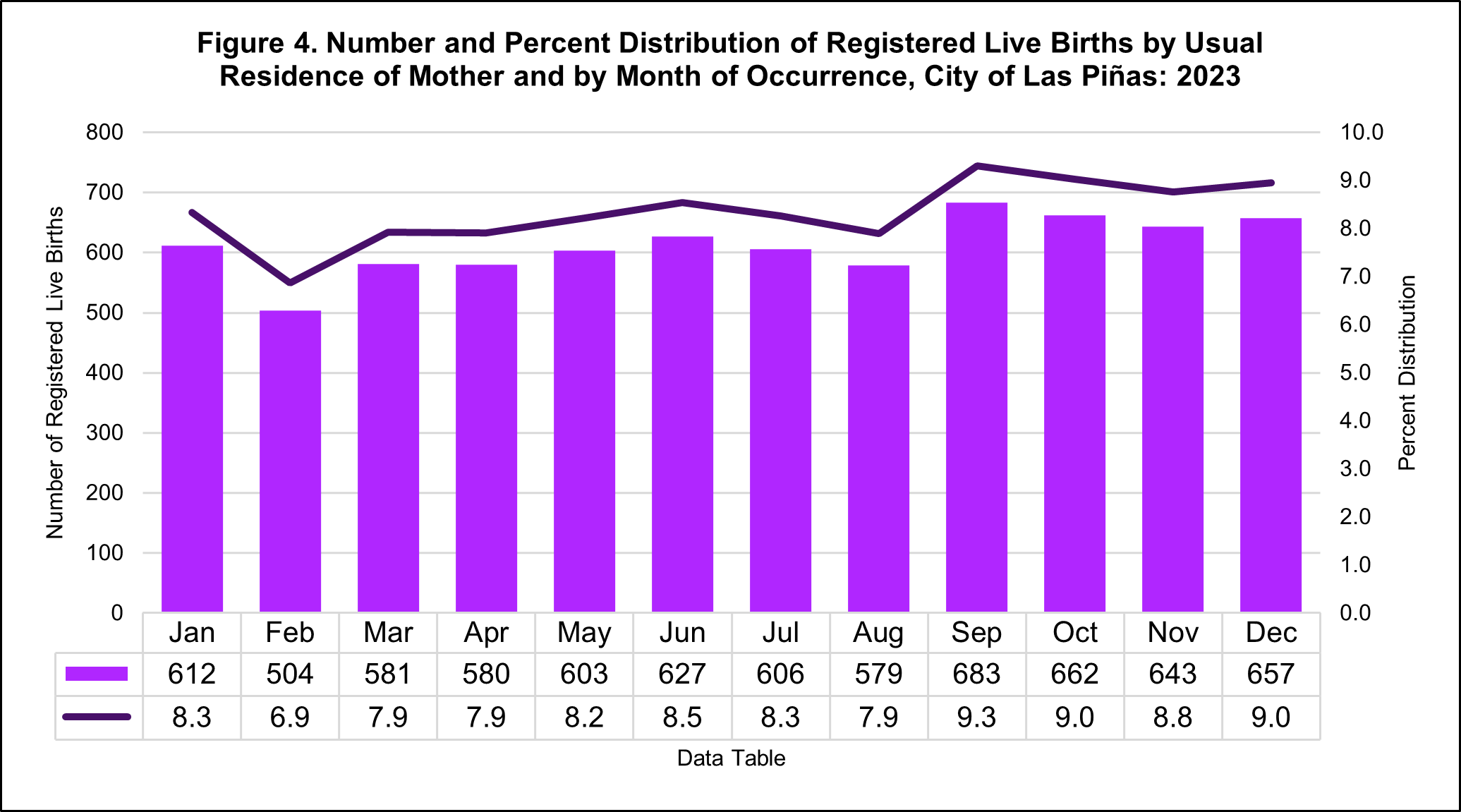
Source: Philippine Statistics Authority, Civil Registration Service, Vital Statistics Division
Proportion of birth deliveries attended by health professionals increased in 2023.
In 2023, a total of 95.1 percent of registered live births were attended by health professionals, indicating an increase of 2.8 percentage points from the 92.3 percent recorded in 2022. This rise reflects a positive trend toward professional medical supervision during childbirth. Conversely, the proportion of deliveries assisted by traditional birth attendants, locally known as hilots, declined from 7.4 percent in 2022 to 4.6 percent in 2023, representing a decrease of 2.8 percentage points. The category classified as “others” remained constant at 0.3 percent across both years. (See Figure 5)
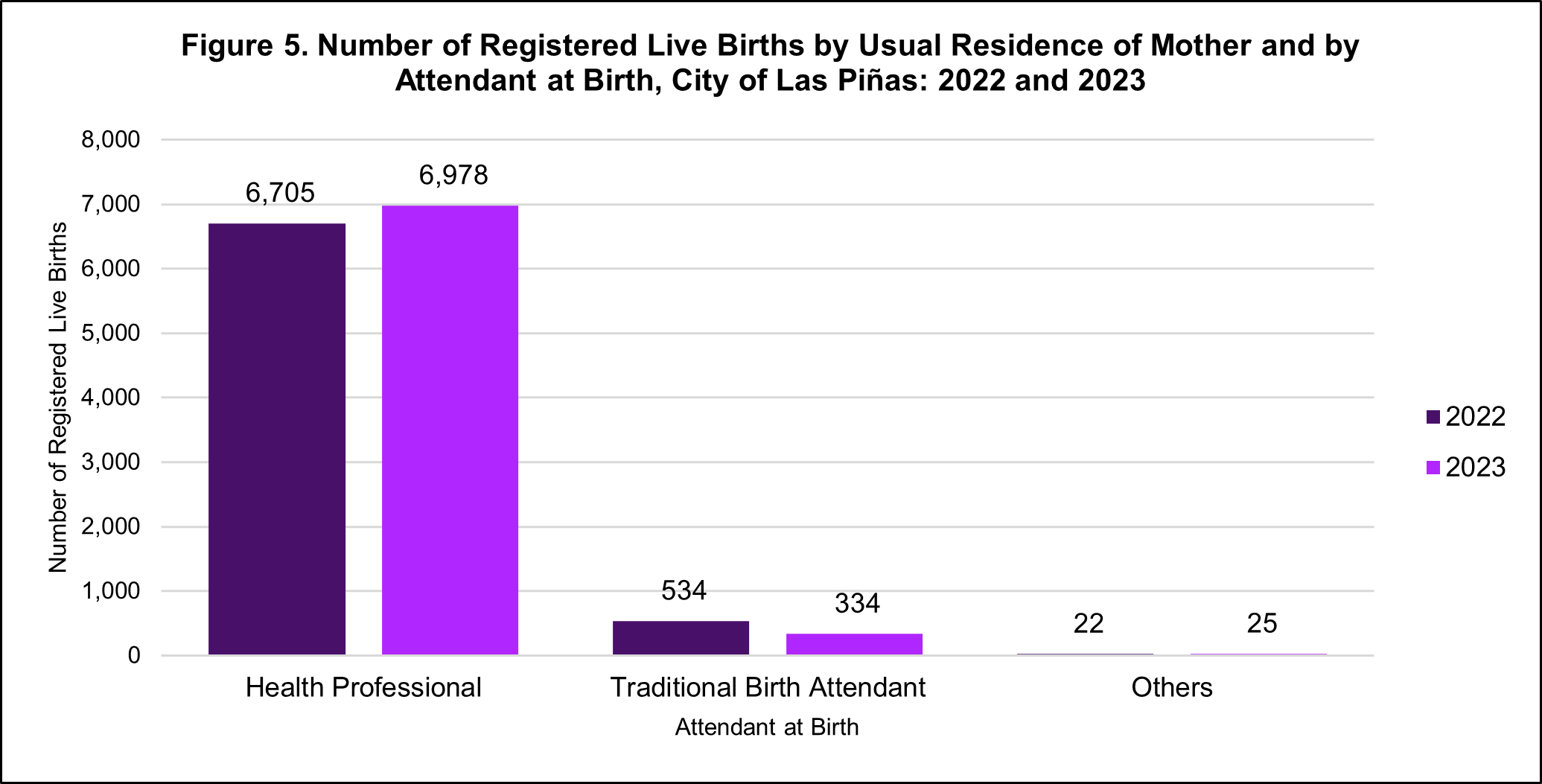
Source: Philippine Statistics Authority, Civil Registration Service, Vital Statistics Division
The majority of registered live births in the City of Las Piñas in 2023 were delivered under the supervision of health professionals, which include physicians, midwives, and nurses. Physicians accounted for the highest share, attending to 67.5 percent of total births. This was followed by midwives at 27.3 percent and nurses at 0.2 percent. In contrast, 4.6 percent of births were assisted by traditional birth attendants, while a minimal 0.3 percent were categorized under "others." (See Figure 6)
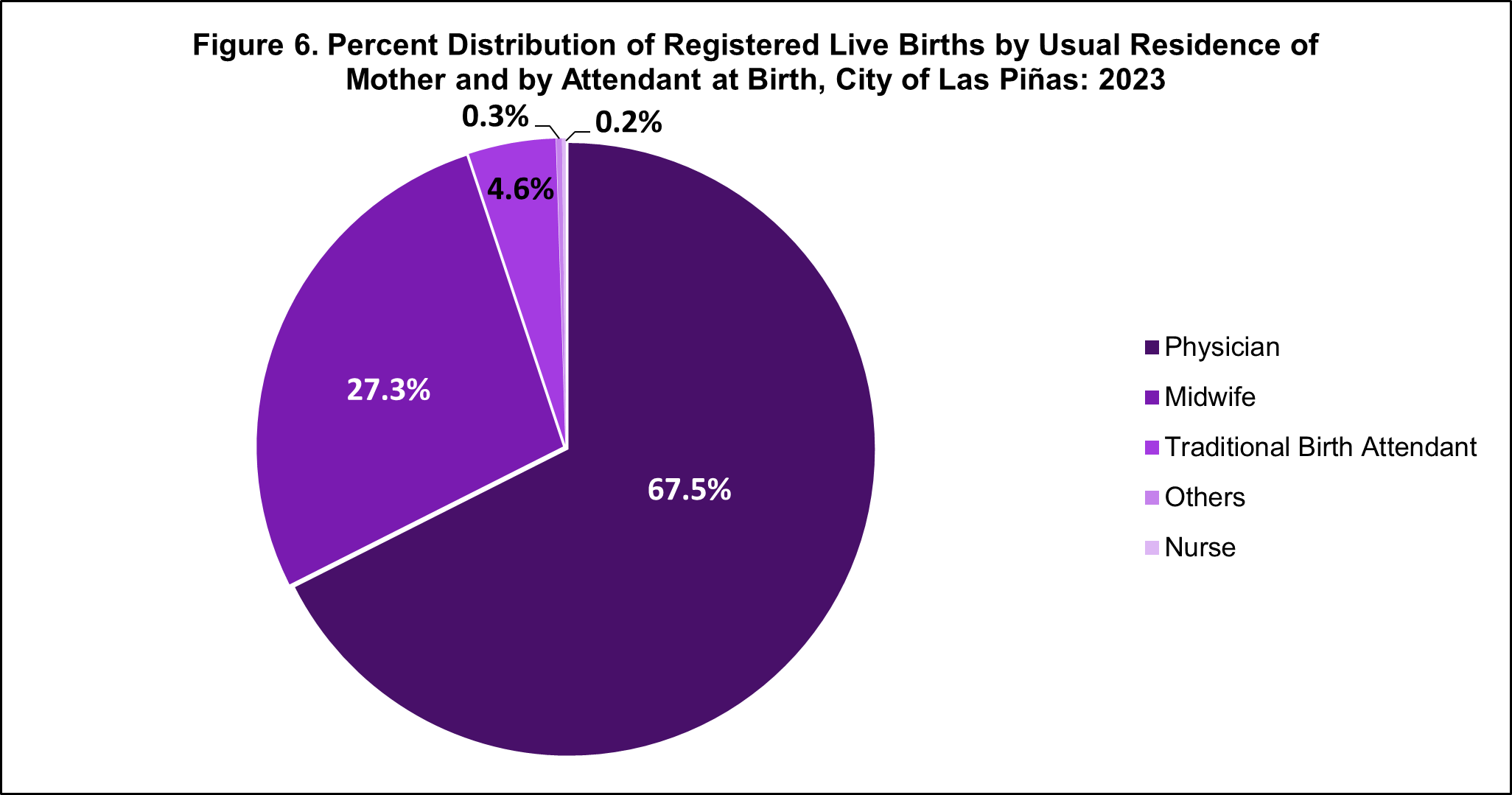
Source: Philippine Statistics Authority, Civil Registration Service, Vital Statistics Division
Note: Details may not add up to 100.0% due to rounding
Rise in deliveries at health facilities observed in 2023.
In the City of Las Piñas, 93.7 percent of total births in 2023 occurred in health facilities, including hospitals, birthing clinics, lying-in clinics, outpatient care centers, and other specialized establishments. This marks a notable increase from the 90.3 percent recorded in 2022, reflecting a sustained shift toward facility-based deliveries. In contrast, only 6.1 percent of births took place at home, while a minimal 0.1 percent were delivered in other locations. (See Figures 7 and 8)
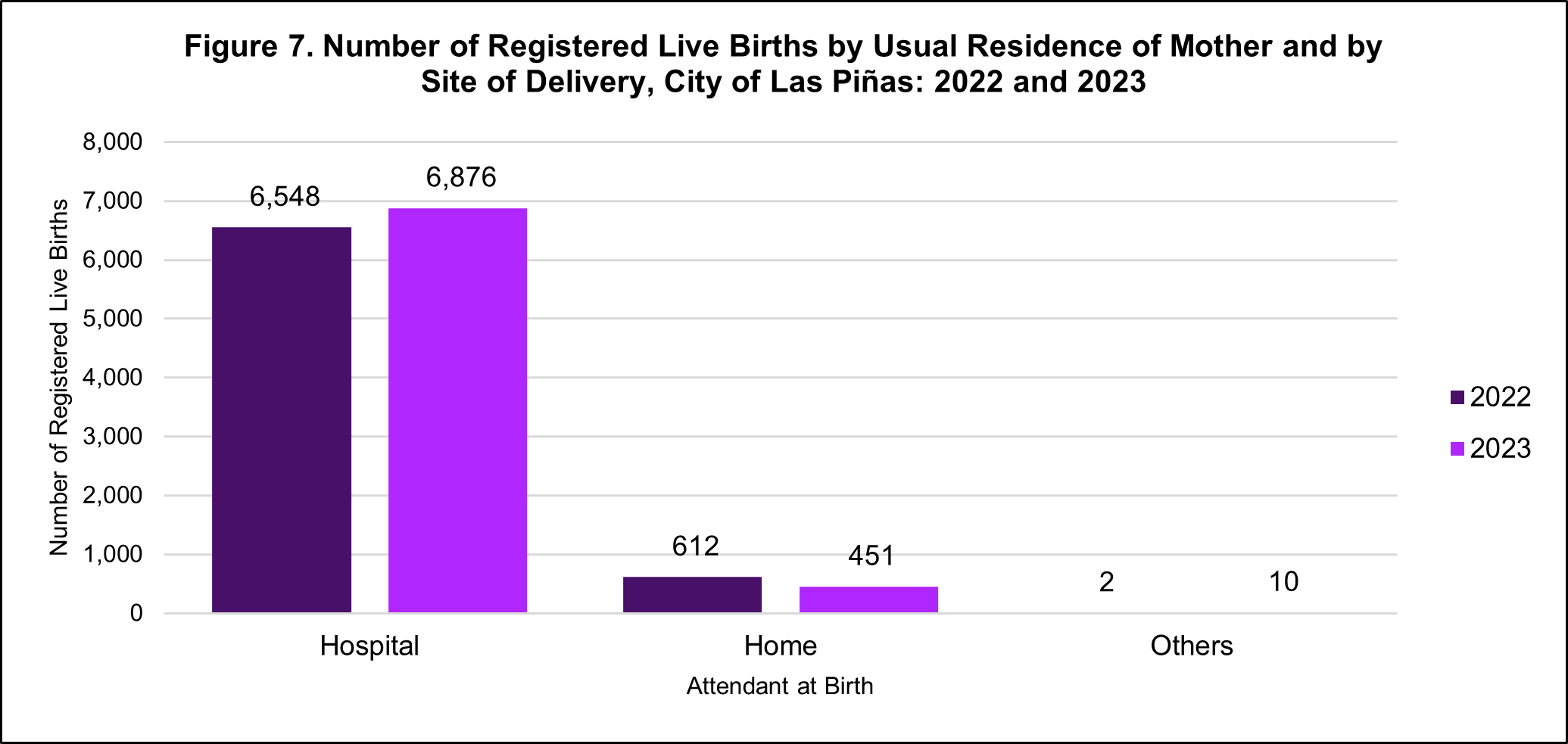
Source: Philippine Statistics Authority, Civil Registration Service, Vital Statistics Division
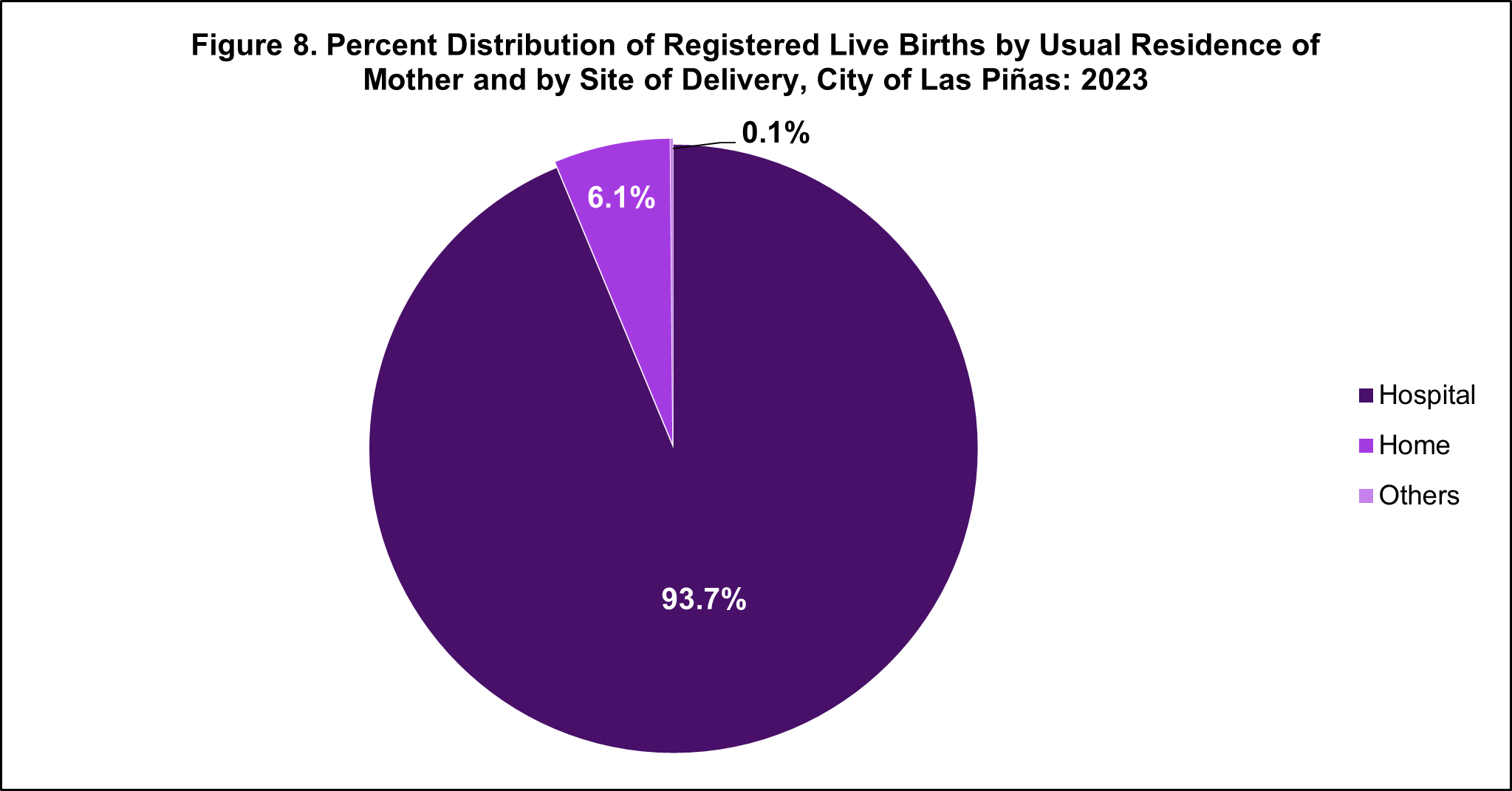
Source: Philippine Statistics Authority, Civil Registration Service, Vital Statistics Division
Most newborn babies weigh more than 2,500 grams.
The nutritional status of newborns is commonly assessed based on their birth weight, with the World Health Organization (WHO) defining low birth weight as less than 2,500 grams (5.5 pounds) at birth.
In 2023, the City of Las Piñas reported that the majority of newborns totaling 6,146 or 83.8 percent of registered live births had a birth weight above the low-birth-weight threshold. This figure shows a slight increase from the 83.7 percent recorded in 2022, indicating a consistent improvement in newborn nutritional outcomes. Among these, the highest proportion of newborns, accounting for 2,747 or 37.4 percent, weighed between 2,500 and 2,999 grams at birth. (See Figure 9)

Source: Philippine Statistics Authority, Civil Registration Service, Vital Statistics Division
The majority of babies are born to father and mother aged 25-34 years old.
The City of Las Piñas recorded a dynamic profile of parenthood in 2023, based on the distribution of registered live births by the age group of both mothers and fathers. The majority of live births were attributed to parents aged 25–29 years, comprising 28.4 percent of mothers and 25.1 percent of fathers. This was closely followed by the 30–34 age group, accounting for 25.1 percent of mothers and 25.6 percent of fathers, affirming that childbearing largely occurs within these prime reproductive years.
Meanwhile, babies born to adolescent mothers, those aged below 20 years reached 7.2 percent of total births. This proportion is more than double the 2.9 percent recorded among adolescent fathers, reflecting that early motherhood remains notably more common than early fatherhood in the city.
A gradual decline in the proportion of births was observed among parents aged 35 years and older. Fathers aged 35–39 years accounted for 15.9 percent of live births, closely mirroring the 15.2 percent share recorded among mothers in the same age group. In contrast, births involving parents aged 40–44 years were less frequent, comprising 4.2 percent among mothers and 7.5 percent among fathers. Live births attributed to parents aged 45 years and older were minimal. Additionally, 5.5 percent of registered births involved fathers whose ages were not reported, whereas the ages of all mothers were fully documented. (See Figure 10)
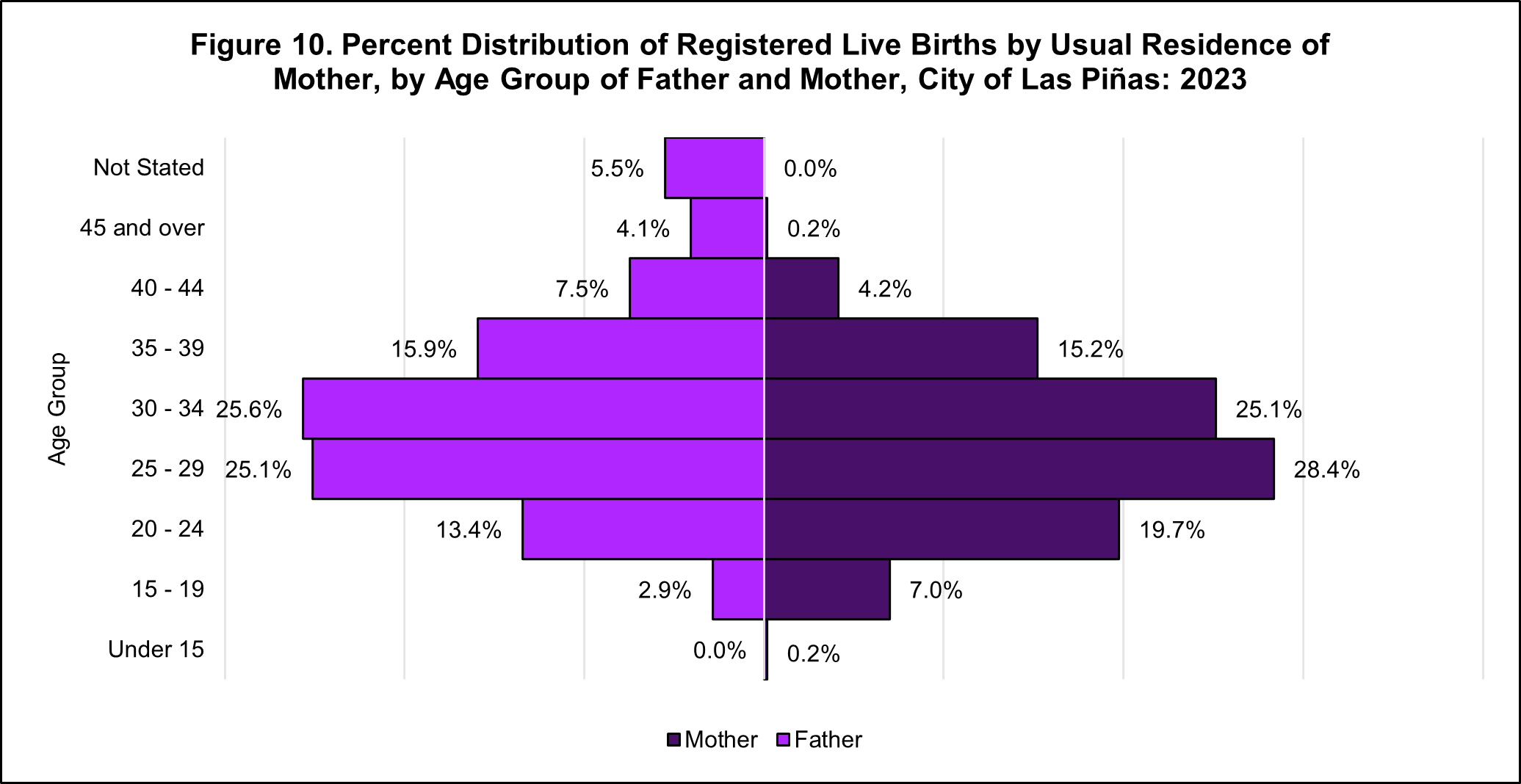
Source: Philippine Statistics Authority, Civil Registration Service, Vital Statistics Division
The median age of mothers at childbirth was 29 years old while for fathers, it was 31 years old. This means that half of the births in 2023 in the City of Las Piñas were to mothers and fathers who were at least 29 years old and 31 years old, respectively.
Those between the ages of 17 and younger and 35 years old and over are considered to be at "high risk" of pregnancy. This is because childbearing in these age groups is more likely to have complications during pregnancy and labor that may result in higher morbidity and mortality for both mother and child.
In 2023, approximately 7.2 percent of newborns were born to mothers younger than 20 years old, while around 19.6 percent were born to mothers aged 35 years and older. (See Figure 11)
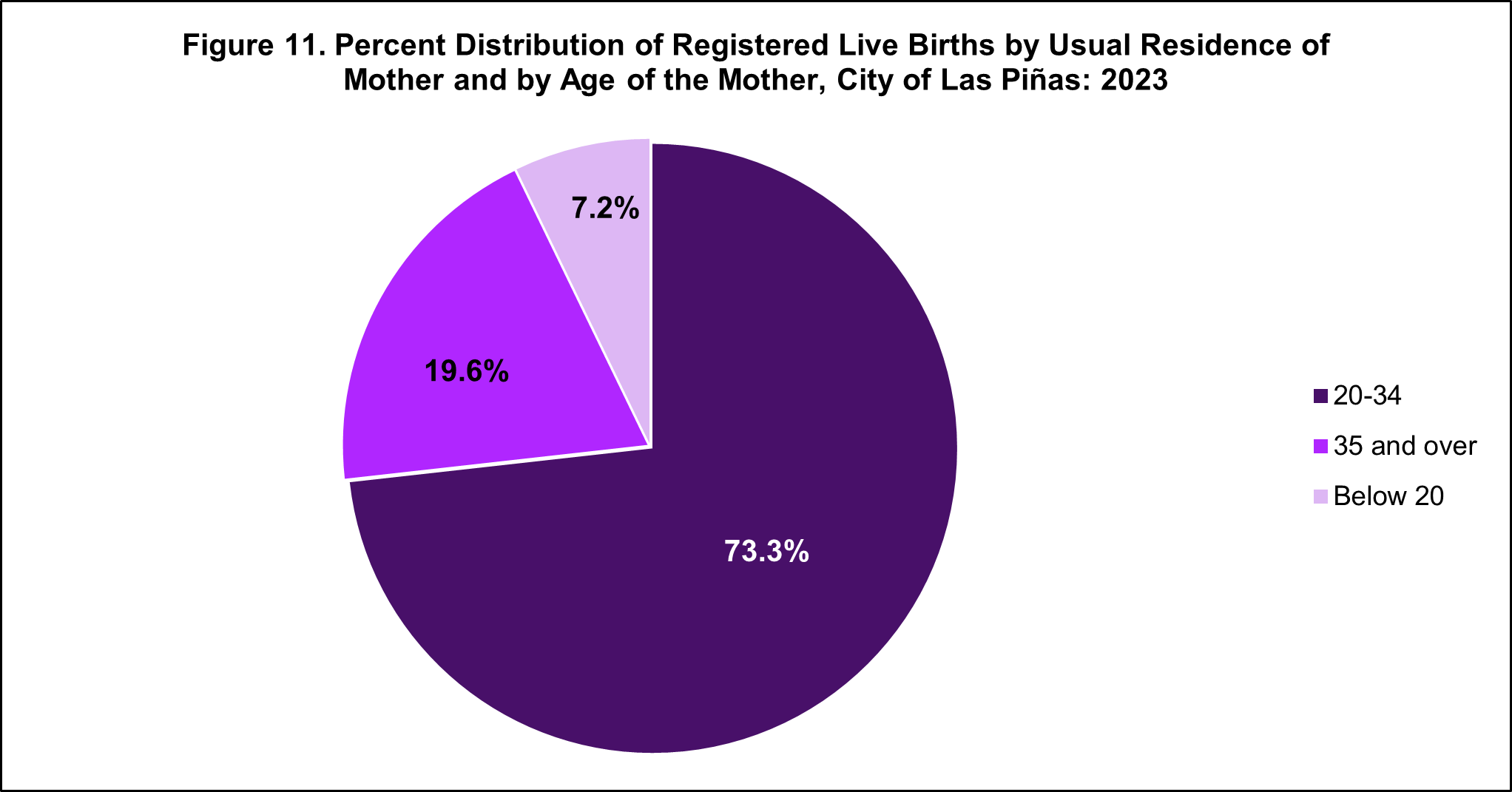
Source: Philippine Statistics Authority, Civil Registration Service, Vital Statistics Division
More than half of newborns were born to unmarried mothers.
The highest incidence of non-marital births in the city in 2023 was recorded among mothers aged 25–29, with 1,539 cases or 29.8 percent of the total. This was followed by mothers aged 20–24, who accounted for 1,358 cases or 26.3 percent, reflecting a notable share among younger women. Meanwhile, 1,025 cases or 19.9 percent were recorded among mothers aged 30–34, indicating a declining trend in this age group’s share compared to those in their twenties. (See Figure 12)
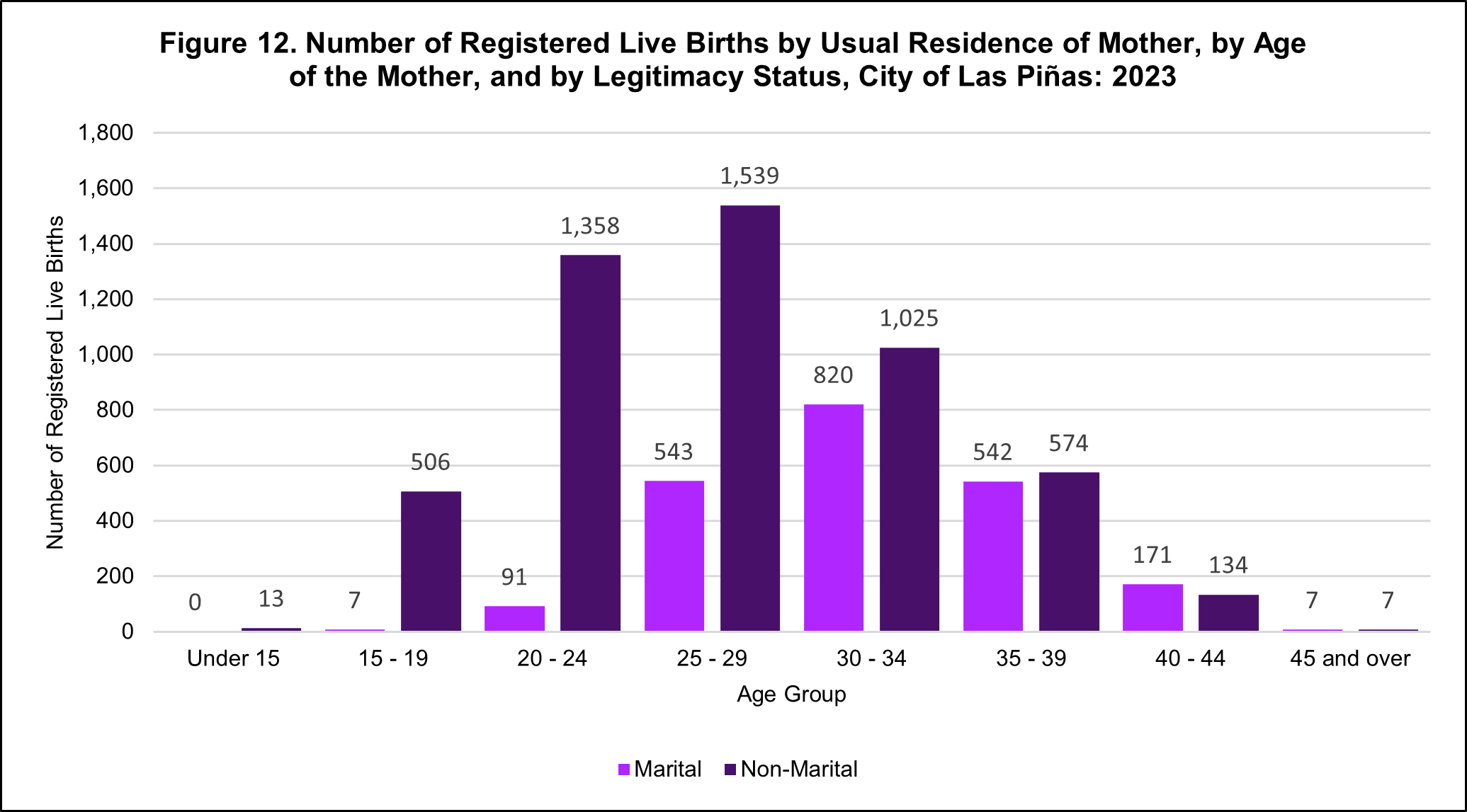
Source: Philippine Statistics Authority, Civil Registration Service, Vital Statistics Division
Moreover, in 2023, a significant majority of live births in the city were classified as non-marital. Out of the total registered births, 5,156 infants or equivalent to 70.3 percent were born out of wedlock, underscoring a prevailing trend of non-marital childbearing. In contrast, only 2,181 births, or 29.7 percent, were to legally married parents, highlighting a substantial disparity between non-marital and marital births during the year. (See Figure 13)
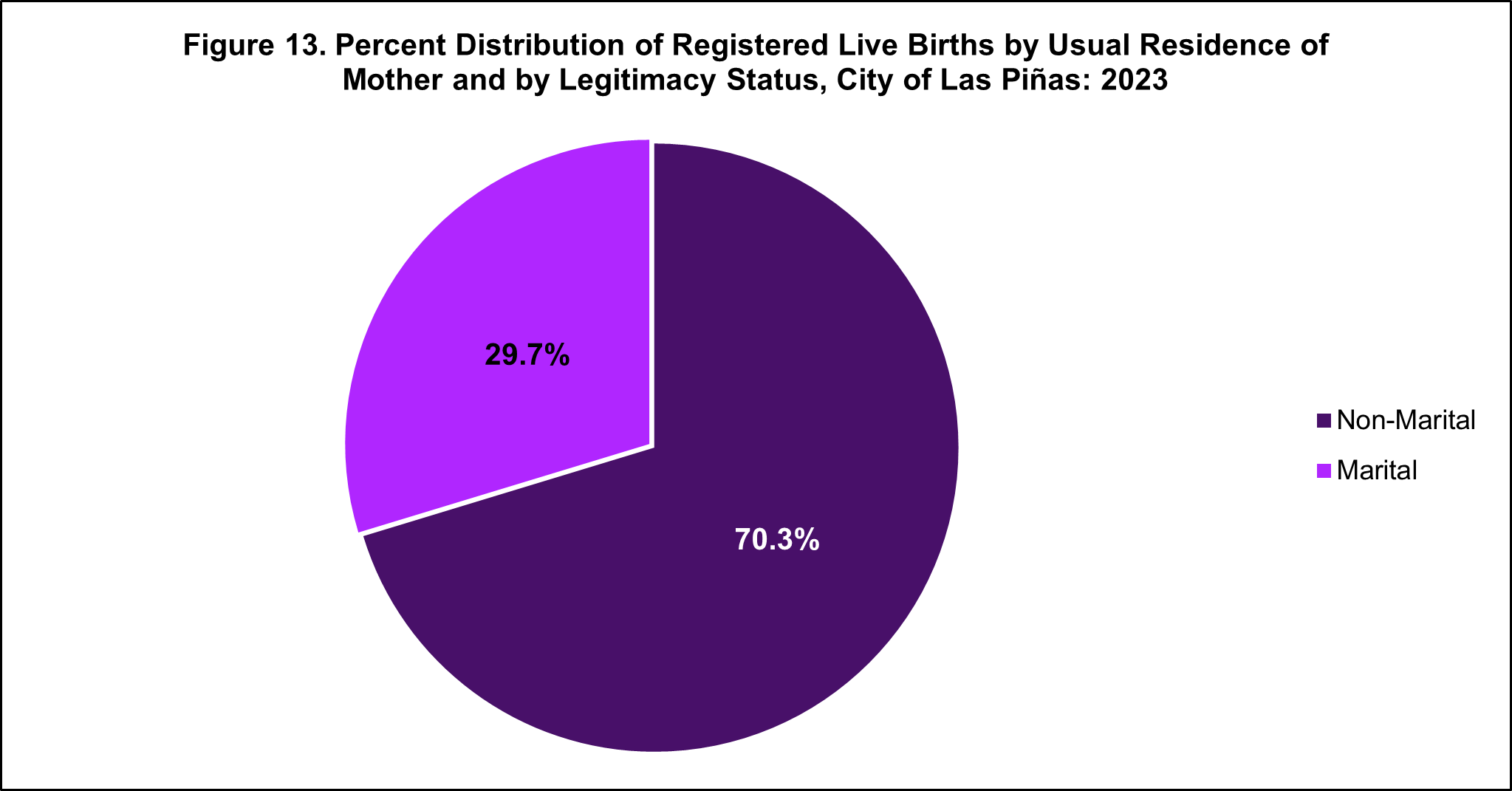
Source: Philippine Statistics Authority, Civil Registration Service, Vital Statistics Division
The city showed distinct patterns in birth legitimacy by mothers’ age. Younger mothers had significantly higher rates of non-marital births with 100 percent among those under 15, 98.6 percent for ages 15–19, and 93.7 percent for ages 20–24. The pattern began to shift among mothers aged 25–29, with 26.1 percent of births being marital. A more balanced distribution appeared at ages 30–34, rising to 44.4 percent, and surpassed 50 percent by ages 40–44, indicating increasing legitimacy with age. (See Figure 14)
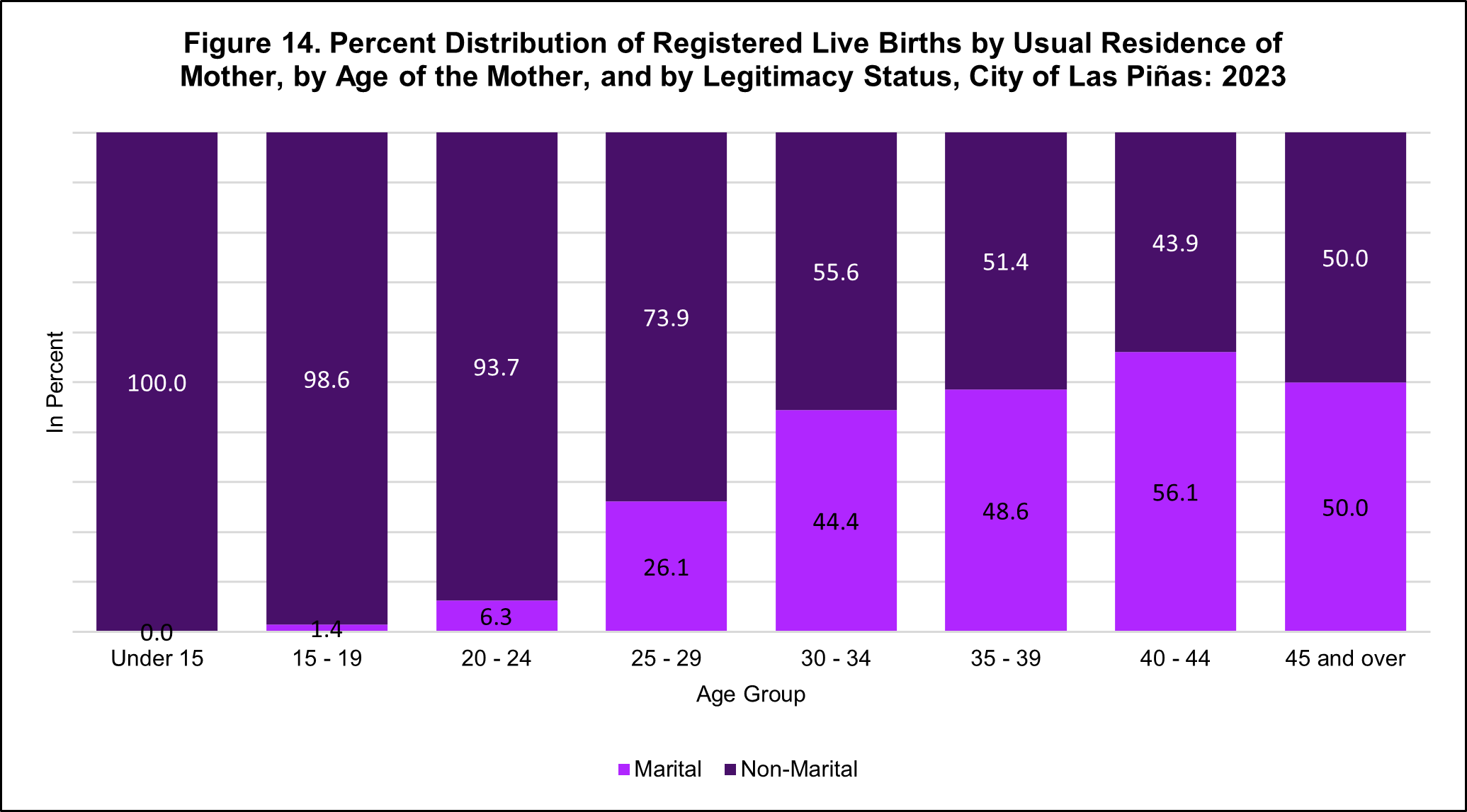
Source: Philippine Statistics Authority, Civil Registration Service, Vital Statistics Division
More than 90 percent were registered on time.
The birth of a child shall be registered within thirty days from the time of birth to be considered a timely registration. In the City of Las Piñas, nine of every ten registered births in 2023 were on time. (See Figure 15)
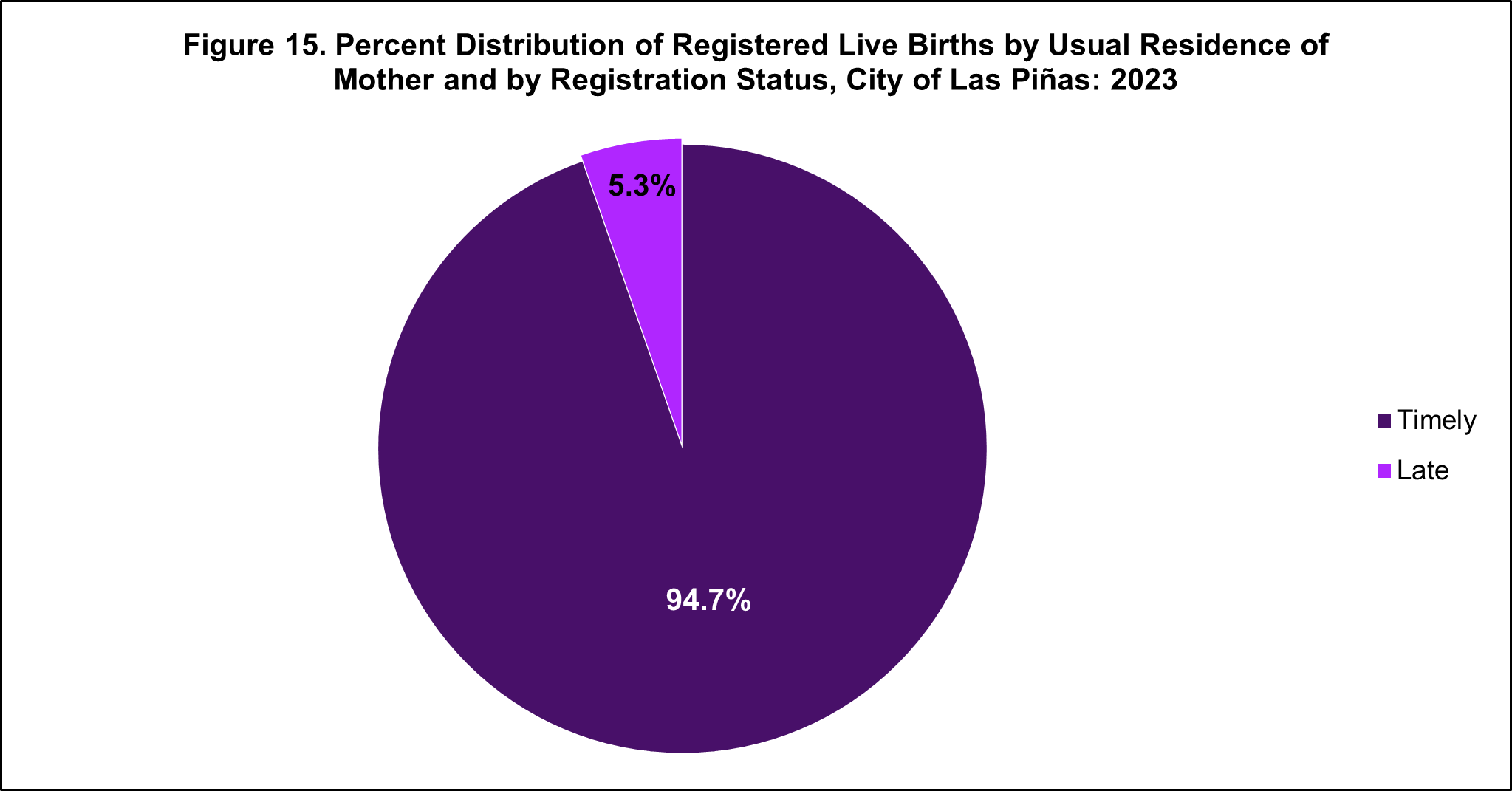
Source: Philippine Statistics Authority, Civil Registration Service, Vital Statistics Division
Technical Notes
Civil Registration is the recording in the appropriate civil registers, vital acts and events that affect the civil status of individuals.
Vital Statistics are derived from information obtained at the time when the occurrences of vital events and their characteristics are inscribed in a civil register.
Vital acts and events are the births, deaths, fetal deaths, marriages, and all such events that have something to do with an individual's entrance and departure from life together with the changes in civil status that may occur to a person during his lifetime. Recording of these events in the civil register is known as vital or civil registration and the resulting documents are called vital records.
• Live Birth - is the complete expulsion or extraction from its mother of a product of conception, irrespective of the duration of pregnancy, which, after such separation, breathes or shows any other evidence of life, such as beating of the heart, pulsation of umbilical cord, or definite movement of the voluntary muscles. Whether or not the umbilical cord has been cut, or the placenta is attached; each product of such a birth is considered live born.
• Sex Ratio - refers to the number of males per one hundred females.
• Usual Residence - refers to the place where the person habitually or permanently resides.
• Crude Birth Rate - The ratio between the number of live births in a population during a given year and the total mid-year population for the same year, usually multiplied by 1,000
For more details, please visit www.psa.gov.ph
ESTRELLA R. VARGAS
Chief Statistical Specialist
Attachments:
1. Table 1. Number and Percent Change of Live Births by Usual Residence of Mother and by Sex, City of Las Piñas: 2014-2023
2. Table 2. Number and Percent Distribution of Live Births by Usual Residence of Mother, by Month, and by Sex, City of Las Piñas: 2023
3. Table 3. Number and Percent Distribution of Live Births by Usual Residence of Mother and by Attendant at Birth, and by Sex, City of Las Piñas: 2023
4. Table 4. Number and Percent Distribution of Live Births by Usual Residence of Mother, by Site of Delivery, and by Sex, City of Las Piñas: 2023
5. Table 5. Number and Percent Distribution of Live Births by Usual Residence of Mother, by Birth Weight, and by Sex, City of Las Piñas: 2023
6. Table 6. Number and Percent Distribution of Live Births by Usual Residence of Mother, by Age of the Mother, by Sex, and by Legitimacy Status: City of Las Piñas: 2023
7. Table 7. Number and Percent Distribution of Live Births by Usual Residence of Mother, by Age of the Father, by Sex, and by Legitimacy Status: City of Las Piñas: 2023
8. Table 8. Number of Live Births by Usual Residence of Mother, by Month, and by Registration Status: City of Las Piñas: 2023
